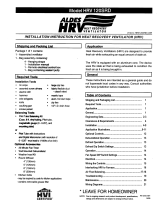9
Air Duct Design and Installation
A well designed and installed ducting system will allow the
HRV to operate at its maximum efficiency.
Always try to keep duct runs as short and straight as pos-
sible. See Installation Diagrams for various installation
options.
The inner and outer liners of the flexible insulated duct
must be clamped to the sleeve of the weather hoods (as
close to the outside as possible) and the appropriate port
on the HRV. It is very important that the fresh air intake
line be given special attention to make sure it is well
sealed. A good bead of high quality caulking (preferably
silicone sealant) will seal the inner flexible duct to both the
HRV port and the weather hood prior to clamping with a
large zip tie.
To minimize air flow restriction, the flexible insulated duct
that connects the two outside weather hoods to the HRV
should be stretched tightly and be as short as possible.
Twisting or folding the duct will severely restrict air flow.
See below for the recommended connection of flexible
insulated ducts to the the outside weather hoods and the
HRV.
Installing the Ducting Between
the HRV & Living Areas in the Home
To maximize airflow in the duct system, all ducts should
be kept short and have as few bends or elbows as possi-
ble. Forty-five degree elbows are preferred to 90° elbows.
Use “Y” tees instead of 90° elbows whenever possible.
All duct joints must be fastened with screws, rivets or duct
sealant and wrapped with mastic or a quality duct tape to
prevent leakage. Mastic is preferred but if duct tape is
used, we recommend aluminum foil duct tape.
Galvanized ducting from the HRV to the living areas in the
house is recommended whenever possible, although flexi-
ble duct can be used in moderation if necessary.
To avoid possible noise transfer through the duct system,
a short length (approximately 12 inches or 300mm) of non-
metallic flexible insulated duct should be connected
between the HRV and the supply/exhaust duct system.
The main supply and return lines to/from the HRV must be
the same size or larger than the duct connection collar.
Branch lines to the individual rooms may be as small as 4
inches (100mm), but 5 inch (125mm) lines are preferred .
All ducts running through attics and unheated spaces must
be sealed and insulated to code.
Fresh Air Ducting
In applications that do not include an air handler, fresh air
should be supplied to all bedrooms and living areas,
excluding bathrooms, kitchen and utility areas. Grilles
should be located high on a wall or in ceiling locations.
Grilles that diffuse the air comfortably such as the Round
Diffuser are recommended.
If the floor is the only option available, then special care
should be taken in locating grilles. Areas such as under
baseboard heaters will help to temper the air. Also option-
al inline duct heaters are available for mounting in the
supply duct work to add heat if required.
Direct Connection to Air Handler Duct System
Should you wish to hard duct the fresh air from the HRV
directly into the cold air return of the air handler, remem-
ber to check the air flow balance of the HRV with the air
handler fan both "ON" and "OFF" to determine that it does
not imbalance the unit more than 10%.
Indirect Connection to Air Handler Duct System
If permitted by local codes, an indirect connection may be
made between the HRV fresh air duct and the air handler
return plenum. The fresh air from the unit may be directed
at a grille installed in the cold air return duct of the air han-
dler. The fresh air outlet from the HRV should be no closer
than 4 inches (100mm) and no more than 12 inches
(300mm) from the grille.























